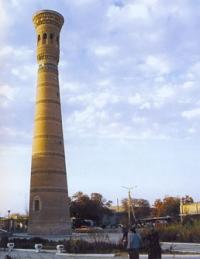You are here
Minaret in Vabkent.

Cultural tourism in Bukhara province.
"I am even ready to become a monument - only to rise above the people"
Michael Genin.
Open spaces in Bukhara.
The minaret in Babkent is located in the vicinity of Bukhara. The special literature notes its similarity with the Kalyan Minaret of Bukhara, but there is a smaller size and poorer Wabkent decoration. Outside the minaret is lined with ground bricks staggered.
Under the lantern of the minaret there is an inscription made of carved terracotta, covered with glaze. The inscription says that the minaret was built by the Bukhara sadra Burkhan ad-Din Abd-al Aziz II in 595 AH (1198 - 1199).
At the entrance to the city a tall minaret can be seen from afar. The minaret in Babkent is one of the most exquisite works of Uzbekistan’s architecture from the end of the 12th century. The construction start date (1196 - 1197) is read among the Kufic inscriptions in the lower decorative tier encircling the trunk.
And in the upper tier it is already written in the hand of "divani": "This minaret was built in the months of 595." The minaret in Babkent has a poorer finish and less than a minaret Kalyan in Bukhara by 7 meters. However, due to the more slender proportions of the trunk, the Wabkent minaret seems higher and looks more elegant than Kalyan.
The minaret is lined with polished bricks outside in a checkerboard pattern. Under the lamp is a glazed inscription, made of carved terracotta. The height of the minaret is almost 39 m, the diameter at the bottom is 6.2 m, at the top is 2.8 m.
The slender trunk of the huge column rising high is crowned with a multi-arch lantern with a lush stalactite cornice at the base and at the top. This rotunda can be reached only by breaking the turns of the spiral staircase.
The trunk of the minaret is decorated with decorative belts (figured brickwork, carved terracotta with epigraphy and geometrically ornamental pattern), between which lie smooth fields of facing. It is lined with pairs of bricks with inlays between the vertical "bows" and dotted shaped bricks, different in all tiers.
Each of them pleases the eye in its own way. The marvelous unity of the composition here is achieved by inventive interpretations of the main method. Kalyan Minaret has a double: in the middle of the XIIth century one of Bako's talented pupils built a similar minaret in Vabkent - a town near Bukhara. It is a well-balanced 39 meters high brick tower.
Vabkent Minaret as well as Kalyan is crowned with a fine arch named 'lamp' by analogy with lighthouse ('minaret' goes from Arabian 'manara' - a place of burning fire, lighthouse). With its size and harmony these two Bukhara minarets defined value and status of minarets in Central Asian architecture as a symbol of Islamic culture.
Authority:
V.G Saakov «History of Bukhara». Publishing house "Shark", 1996. «Bukhara. Masterpieces of the Central Asia». The historical guidebook across Bukhara. 2012. "Bukhoro. Bukhara" In the Uzbek, English and Russian languages. Publishing house "Uzbekistan", Tashkent 2000. Mukhammad Narkshakhi. History of Bukhara. Tashkent. 1897 (translator N.Lykoshina). V.G.Saakov "Architectural masterpieces of Bukhara. A Bukhara regional society "Kitabhon" Uzbek SSR, Exactly 1991 Robert Almeev. "History of ancient Bukhara". (Under edition of the Academician of the Academy of sciences of Republic Uzbekistan of Rtveladze E.V.).







